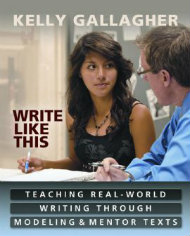Real World Writing Strategies
Write Like This: Teaching Real World Writing Through Modeling and Mentor Texts
By Kelly Gallagher
(Stenhouse Publishers, 2011 – Learn more)
When I first read the title of Kelly Gallagher’s latest book, Write Like This: Teaching Real-World Writing Through Modeling and Mentor Texts, my first reaction was, “Is this going to be another scripted, follow-the-dots, do-not-pass-go type of teaching guide?” Just the opposite, as it turns out. Gallagher’s approach to writing instruction is practical, relevant and doable by any teacher, which is particularly exciting news for those of us who are not English specialists.
In a nutshell, Gallagher’s teaching “formula” is:
1. Teach students real-world writing purposes
2. Teacher models his/her struggles with the writing process by writing in real time in front of students
3. Include many real-world mentor texts for students to emulate
4. Give students the time necessary to write and grow as writers
 Beyond “covering the standards”
Beyond “covering the standards”
Gallagher’s philosophy for writing instruction is simple. He argues that in order for students to become adults who are able to write effectively in real world situations, teachers need to move beyond a ’cover the state standards’ mind-set by introducing student writers to additional real-world writing opportunities. To achieve this, teachers need to employ authentic modeling, act as teacher mentors and use real-world texts.
A student remembers
To support his argument, Gallagher presents a comical yet thought-provoking scenario of an unlikely conversation between an English teacher and a former student. Student: “Oh, it is so good to see you! I was hoping to run into you some day so that I can tell you that I am still writing essays that analyze the author’s use of tone. I keep a “Tone Journal” at home, and I apply that skill you taught me 20 years ago in the tenth grade to everything I read today! Let’s have lunch some day so I can share all the essays I have written recognizing the author’s tone found in all the books I have read since high school graduation.”
Copious resources
Each chapter, which focuses on a different type of real-world writing, is packed full of lesson ideas and includes suggested mentor texts, examples of teacher modeling that Gallagher has done with students, and examples of student work. He also addresses revision and editing. This is where the strength of the book lies. Gallagher is a fine writer, and after stating his writing philosophy convincingly, he has organized and communicated his lesson ideas in an effective and inspiring way.
Adapt for middle grades?
As Gallagher is a high-school English teacher, it’s no surprise that many of his lesson ideas and choices of mentor texts were more suitable for high school students. It would be nice to see suggested mentor texts at the middle school level, but don’t let this detract from the book’s usefulness to middle school teachers. As I was reading, I found myself making middle school adaptations to my favorite lesson ideas, and this was easily done. That said, I would love to see Gallagher write a book focused on balanced literacy instruction at the middle school level.
Gallagher has inspired me to reflect on my writing instruction, and I will definitely be thinking about real-world writing applications in my classroom this year.
Rhonda Leduc is a grade 6 middle school teacher in Victoria, British Columbia, with a particular interest in technology use in schools and connecting students to the world beyond their own. Rhonda has a Bachelor of Education and a Bachelor of Music degree from the University of Victoria and a Master of Education degree in Educational Policy Studies with a focus in Global Studies in Education from the University of Illinois at Urbana-Champaign.
For another teacher’s take on Write Like This: Teaching Real World Writing Through Modeling and Mentor Texts, read Francesca LoGiudice’s overview of the book’s content in an earlier MiddleWeb post.






























